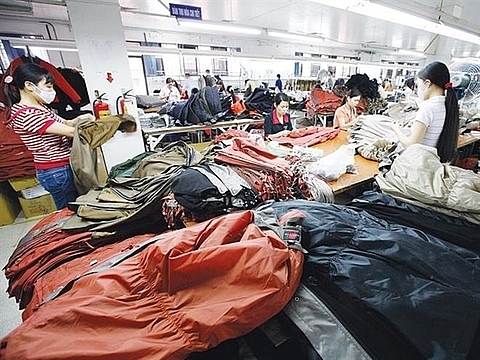Vietnamese firms urged to make use of CPTPP
 |
| Garment and leather shoe firms have taken advantages of certificate of origin in the CPTPP. |
The Ministry of Finance (MoF) submitted a decree on preferential export tariffs and special preferential import tariffs of Vietnam under the CPTPP from the period January 14, 2019 to December 31, 2022.
Under the decree, the MoF and General Department of Customs tried to compare the taxes of free trade agreements (FTAs) with the CPTPP so that businesses can choose appropriate preferential tax rates.
The preferential tariffs include two country groups. One group has implemented the CPTPP since the end of 2018, including Canada, Australia, New Zealand and Singapore and another group will start from 2019. Accordingly, when enterprises import goods, they need to read the tariff to understand the tax reduction schedule. For example, if the goods are imported from Australia, the roadmap is the second year, while imports from Mexico will come under the first year.
It is expected that the tax reduction would be applied to some 300 products. However, businesses are required to have preferential certificate of origin (C/O) to enjoy the preferential tariffs. C/O in CPTPP is a certificate that can be issued to multiple shipments on condition of not exceeding 12 months and can be issued to many different importers.
Earlier, Canada immediately eliminated tariffs on fishery products, especially key products of Vietnam. Rice and products containing rice, coffee, green tea, fruit and vegetables also saw the majority of tariffs eliminated at the time the commitments started.
According to the MoIT’s Import-Export Department, many exporters of garment and textile and leather shoes have taken advantage of the C/O principles under the CPTPP when exporting to Canada. In the Japanese market, the majority of seafood products which Vietnam has an advantage, such as frozen and processed shrimp, enjoy zero tax right after the CPTPP took effect.
However, the MoIT said the tax reduction is only one of the preferential items for Vietnamese goods. Businesses still have to ensure their products meet quality and technical standards as well as have certificates of origin from importers.
Pham Thiet Hoa, director of the Investment and Trade Promotion Centre of HCM City (ITPC), said import and export activities of local businesses are subject to control of CPTPP's both incentives and strict requirements.
Among 10 members of the CPTPP, Vietnam signed FTAs with seven countries, of which four countries have relatively high bilateral import-export turnover, reaching nearly US$7 billion. For countries that have not signed bilateral FTAs such as Canada or Mexico, export turnover stood at $4.6 billion and $3.4 billion in 2018, respectively. Particularly, in the first quarter of 2019, Vietnamese goods exported to Canada reached $864 million, up 42.7 per cent over the same period last year.
However, for these markets, Vietnam's exports account for only 1-2 per cent of the total import turnover of each country. With a large market capacity and the difference in tax incentives before and after the CPTPP took effect, Canada and Mexico will be potential export markets for Vietnamese enterprises. In particular, Vietnamese industries which have advantages such as footwear, textiles, aquatic and wood products are predicted to have high export growth rates, if they make good use of incentives.
In reality, Vietnamese enterprises have often only paid attention to trade issues such as quality, quantity of goods, time of delivery and receipt, but neglect the legal factors such as applicable law and provisions on dispute resolution. In order to limit this, even at the negotiation stage, Vietnamese enterprises need to actively agree with partners on these components as a way to prevent possible disputes.
After four to five months of CPTPP implementation, Vietnam's trade with some member countries has increased compared to the same period last year. For example, Vietnam's trade with Canada was increased by over 70 per cent, Mexico over 8 per cent. With Japan, Vietnam has an agreement within ASEAN, but trade in the past 4 months has also increased by 4 per cent.
What the stars mean:
★ Poor ★ ★ Promising ★★★ Good ★★★★ Very good ★★★★★ Exceptional
Related Contents
Latest News
More News
- First members of Danang International Finance Centre revealed (December 22, 2025 | 17:39)
- Human-centred governance seen as key to AI development (December 19, 2025 | 18:19)
- Top 10 notable events of Vietnam’s industry and trade sector in 2025 (December 19, 2025 | 14:00)
- Tungsten surges to 12-year high as world enters a new 'black gold' race (December 18, 2025 | 17:27)
- Vietnam’s coffee exports set new record despite price pressures (December 18, 2025 | 17:13)
- Garment and textile sector seeks new growth after volatile year (December 18, 2025 | 17:01)
- VinSpeed and Siemens strengthen cooperation for high-speed rail development (December 18, 2025 | 16:53)
- High-tech adoption for TH true MILK (December 18, 2025 | 13:39)
- Takeda supports health resilience amid climate change challenges (December 18, 2025 | 12:39)
- Mondelez Kinh Do - a chapter of purpose-led leadership in Vietnam (December 18, 2025 | 09:44)

 Tag:
Tag:






















 Mobile Version
Mobile Version